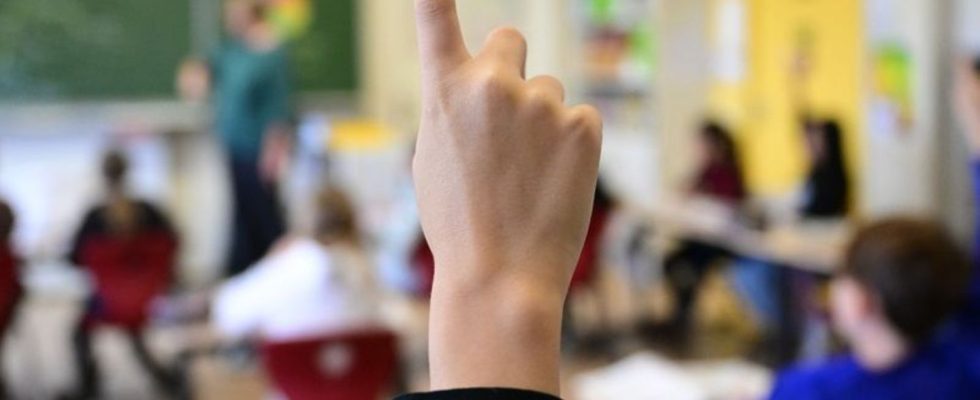Don’t spill, but rather – that’s the motto of a new program to support schools in difficult social situations. Now it has been sealed. What does it do – and what doesn’t?
The federal and state governments have agreed on a billion-dollar program to support schools in difficult social situations. The Conference of Ministers of Education and Cultural Affairs approved a corresponding proposed resolution, as the German Press Agency learned. Politicians have high hopes for this. Experts see many positive points, but also point out what is missing.
What is the starting position?
The two educational researchers Nele McElvany and Ulrich Ludewig from the TU Dortmund point out that family background still has a major influence on educational opportunities in Germany. There are also increasing numbers of students who need special support, for example in German.
Educational studies show a decline in skills. A PISA study published in December documented that German students performed worse than ever before in 2022. In reading as well as in mathematics and natural sciences, these were the lowest values ever measured for Germany as part of Pisa.
What is the Start Chances Program?
The program is to be launched and financed jointly by the federal and state governments in order to support around 4,000 general education and vocational schools nationwide that have a high proportion of socioeconomically disadvantaged students.
The key points published in September state that the program is intended to break the strong connection between social background and educational success. It is intended to help the education system in Germany become better and more efficient. At the same time, it is one of the traffic light government’s most important educational policy projects.
What is the specific goal?
The aim is to improve the students’ skills, especially in reading, writing and math. “By the end of the program, the number of students who fail to meet the minimum standards in mathematics and German should be halved at the StartChance schools,” it says in the corner points. Around a million students nationwide are expected to benefit.
When should the program start?
The starting point is the coming school year 2024/2025. However, according to the key points, it could be that due to the planning and preparation time, only around 1,000 schools will initially start and then the number of 4,000 schools will be reached by the 2026/27 school year.
Who pays for the program?
It is planned that the federal government will provide around one billion euros annually and the states will contribute the same amount. Over the planned period of ten years – until the end of the 2033/24 school year – that would be a total of 20 billion euros. Given the tight public purse, this is a feat of strength. The states can count existing programs towards co-financing.
What does the program include in detail?
Schools should have a better and more modern learning environment. They can also set their own financial priorities using an “opportunity budget”. In addition, the development of teams made up of social workers, social educators and other specialists should be promoted.
How are the schools selected?
The states name the schools. According to education researcher Dirk Zorn from the Bertelsmann Foundation, they need to introduce a “social index” for schools in order to be able to select the schools with the greatest need for support. According to the key points, the criteria “poverty” and “migration” should be given special consideration.
What do experts rate positively about the program?
Educational researcher Zorn speaks of a “paradigm change” in the German education system. The money will no longer be distributed according to the watering can principle, but according to actual needs. It is also positive that 2,400 of the 4,000 schools supported will be primary schools. The problems are often particularly big there – but that is also where the greatest impact can be achieved.
The two researchers McElvany and Ludewig see it similarly: placing the focus on schools in challenging locations, and especially on primary schools, is a very sensible approach.
What do experts assess critically about the program?
Expert Zorn says: “In my opinion, the program is too small.” The money is not enough given the size of the problems. In addition, schools especially need more positions for teachers. McElvany and Ludewig also point out this: “The program cannot change the shortage of teachers in the short term.”
And what about the digital pact?
The digital pact, initially worth five billion euros from the federal government – it has been financially increased several times – is a funding program for the technical expansion of schools, for example with WiFi or tablets. It expires in the spring. Some politicians in the federal states are angry because a successor pact has not yet been finalized. Federal Education Minister Bettina Stark-Watzinger (FDP) recently said that the federal government stands by Digital Pact 2.0, but that the funds from the first pact must first be used – that is not yet completely the case.
Expert Zorn says clearly: “Digitality is part of school today and that actually requires more than a pact.” Permanent, sustainable financing is necessary. “Efficient digital equipment must be as commonplace today as blackboard and chalk were in the past.” There is a lack of a uniform reform strategy for the German education system. “We would need an effort from society as a whole to achieve this. We are still a long way from that at the moment.”

